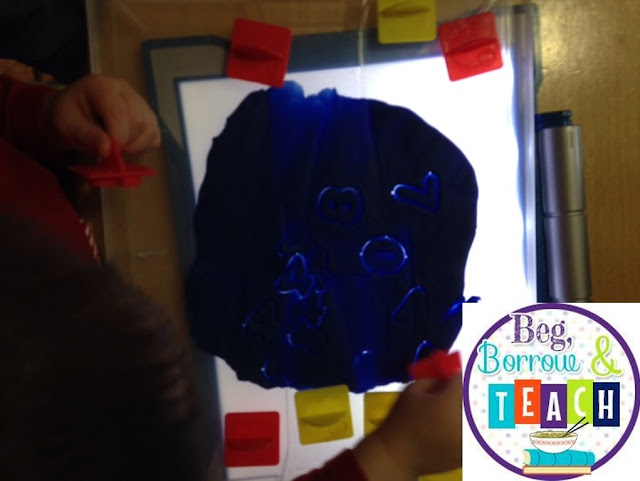Searching for an activity that offers the ability to review reading, writing, and math while also appealing to kids' senses? How about a fun sensory station for your Fun Friday/PAT time or a rainy day activity? Then you want to check out this post on using the light box to play and teach!
Before I begin my post I want to share that I read many things about DIY light boxes, and the bottom line is that they are not really safe. They can damage eyes if they lights used are too bright, and they pose a safety hazard for younger children if they are opened accidentally. It was after reading these things that I decided on this
Crayola Light Up Tracing Pad. It got good reviews online and it was compact enough to store when not in use.
There are so many educational, yet fun, activities that can be done with a light box or table. Below are some of my favorites.
1.
Trace numbers, letters, and shapes on top of a gel sensory bag. You can read more about how to create a gel sensory bag in
this post.
For older children: You can also place worksheets beneath the bag, like in the picture below. Think of it like a dry-erase board with a sensory benefit.
2.
Roll out Play-Doh in a clear container and use cookie cutters.
For younger children, this can be as simple as letters, numbers, and shapes.
For older children: Have them create number sentences/equations with the numbers, spell out words with the letters, or create patterns.
3.
Put translucent objects on the light table and have the child match colors, sizes, or quantities. I spread the pieces of
this pill sorter out and gave my son some
plastic reusable ice cubes from the Dollar Tree and plastic eggs to match to them by color. To add some fine motor practice, I gave him tongs designed for catching bugs with which to pick up and sort the objects. The bug catcher is part of this fine motor set.
For older children: Have them practice writing out the colors and shapes as they identify and sort them.
4.
Put an I-Spy bag on the light table for discovery of objects/letters. You can read more about how I made my I-Spy bag by clicking
here. Younger children can verbalize what they see. My son loves using it almost like a rain stick, just turning it over to listen to the rice filter through the objects.
Older children: Practice writing out the words on paper or dry-erase boards as the objects are found.
5.
Use discovery bottles for letter/word recognition.
For older children: Give them flash cards with words on them. Have them find the letters needed to spell the words on the cards. Have them write out the words as they find the letters in the discovery bottle.
What's on my light box wish list?
In the future, I would love to build structures or do division/ multiplication problems with these translucent
Prism Bases and
Prism Blocks that resemble see-through Duplo Blocks. We can also use them to talk about area and perimeter.
What are your must-haves for your light box? I'd love to hear what activities you do for playing and learning!
























